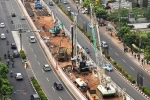Transportation Minister boosts acceleration of Maros-Mandai railway line project
This article has been translated by PwC Indonesia as part of our Indonesia Infrastructure News Service. PwC Indonesia has not checked the accuracy of, and accepts no responsibility for the content.
Investor Daily - Menhub dorong Percepatan Proyek Jalur KA Maros-Mandai
24 January 2023
Jakarta - Transportation Minister Budi Karya Sumadi is boosting the completion of Maros-Mandai railway line that is part of the construction of the national strategic project Makassar-Parepare railway. The construction of Maros-Mandai railway line is currently underway, but it is still hindered at several locations regarding land acquisition.
“We have coordinated with regional governments, DPR (House of Representatives) Commission V, and Forkopimda (Regional Leadership Coordination Forum) to resolve this issue. Alhamdulillah (Praise be to God), all parties state that they support accelerating the completion, so we can continue the construction,” the Transportation Minister said in his official statement when he visited Makassar-Parepare railway construction project last weekend.
Currently, the operational railway line starts from Garongkong Station to Maros Station spanning 80 km. If Maros-Mandai line that spans 4 km has been completed, the total length of the operational line will reach 84 km, starting from Garongkong Station to Mandai Station.
In December 2022, a limited trial for the railway service from Garongkong Station to Maros Station was conducted. During the free trial period, the people’s interest in the railway was quite high. On 25 December 2022, the number of passengers reached 333 people in one day.
Several tourist attractions along the line are one of the reasons why the people are interested in the railway. The tourist attractions are Anjungan Sumpang Binangae Nature Tourism and Ujung Batu Beach Nature Tourism near Barru Station, Laguna Beach Nature Tourism and Lappa Laona Nature Tourism near Tanete Rilau Station, Sorongan Nature Tourism near Mandalle Station, Telaga Biru Segeri Nature Torusim near Ma’rang Station, Dewi Biringkassi Mangrove Forest Nature Tourism near Labakkang Station, Tonasa Park, Hijau Balocci Lake, as well as Purbakala Sumpang Bita Park near Pangkajene Station, Kampoeng Karst Rammang-Rammang, Leang Leang Archaeology Park, as well as Toakala Lake near Rammang-Rammang Station, Calm-water Beach, Mangambang Nature Tourism, as well as Bantimurung Waterfall near Maros Station.
Currently, the railway service from Garongkong Station to Maros Station is fully operational every day. It goes through nine stations. After the improvement and compression of the land structure, the train’s speed was increased from 60 km per hour to 110 km per hour.
Meanwhile, the Transportation Ministry is also preparing bus transportation using the buy the service scheme from Mandai Station to Sultan Hasanuddin Airport to achieve combined transport.
Besides serving passengers, Makassar-Parepare railway also serves logistics distribution through freight train transportation in Garongkong Port as well as Tonasa and Bosawa Cement Industrial Estates.
Speed increase
Furthermore, Railways Director General Risal Wasal explained that the speed of the first railway in Sulawesi could reach 110 km per hour. Since the limited trial in October 2022, Makassar-Parepare railway has continued to increase its speed.
“Land structure and ballast improvements along the railway line allowed for more speed on certain segments. Moreover, segments with a speed limit of up to 100 km per hour include KM 74-KM 90 and KM 18-KM 44 on segments B and F,” Risal said on Saturday (21/1/2023).
With the speed increase, the travel time of Makassar-Parepare railway from Maros to Garongkong can be cut to 68 minutes from 86 minutes.
“The speed will continue to increase along with the improvement of the railway track that we are currently constructing to be operated to serve the people,” Risal mentioned.
Besides the construction that is almost completed, Risal also explained that operating the railway with high speed was possible because the width of the railway track reaches 1,435 mm. The width of the track is different from railway tracks in Java and Sumatra where the width of the railway tracks is only 1,067 mm.
“With the width of the track, the railway can go faster and carry more freight compared to trains in Java,” Risal explained.


















